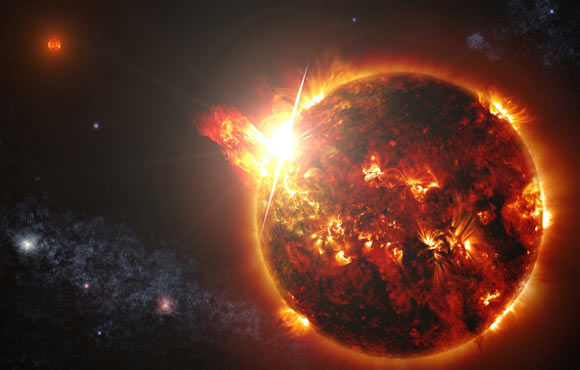Coronal mass ejections (CMEs), often associated with solar flares, are the most powerful magnetic phenomena occurring on the Sun. Now, astronomers using NASA’s Chandra X-ray Observatory have spotted a gigantic CME erupting from the active star HR 9024. This is the first time a CME has been seen in a star other than our Sun. The results, published in the journal Nature Astronomy, confirm that CMEs are produced in magnetically active stars and are relevant to stellar physics.

This artist’s illustration depicts a coronal mass ejection, which involves a large-scale expulsion of material, and have frequently been observed on our Sun. Image credit: NNASA / CXC / INAF / Argiroffi et al / S. Wiessinger.
CMEs are massive clouds of solar plasma threaded with magnetic field lines that are ejected from the Sun over the course of several hours.
Although the Sun’s corona has been observed during total eclipses of the Sun for thousands of years, the existence of CMEs was unrealized until the space age.
CMEs are often associated with solar flares and prominence eruptions but they can also occur in the absence of either of these processes. The frequency of CMEs varies with the sunspot cycle.
“The technique we used is based on monitoring the velocity of plasmas during a stellar flare,” said Dr. Costanza Argiroffi, an astronomer with the University of Palermo and Italy’s National Institute for Astrophysics.
“This is because, in analogy with the solar environment, it is expected that, during a flare, the plasma confined in the coronal loop where the flare takes place moves first upward, and then downwards reaching the lower layers of the stellar atmosphere.”
“Moreover, there is also expected to be an additional motion, always directed upwards, due to the CME associated with the flare.”
Dr. Argiroffi and colleagues used X-ray spectroscopy data from the High-Energy Transmission Grating Spectrometer (HETGS), an instrument aboard NASA’s Chandra X-ray Observatory.
They analyzed a particularly favorable stellar flare detected from HR 9024, a giant star located 455 light-years away in the constellation of Andromeda.
Also known as HD 223460 and OU Andromedae, this star is almost 10 times larger than our Sun and about 3 times more massive,
The results of the Chandra observations clearly show that, during the flare, very hot material (between 18 to 45 million degrees Fahrenheit, or 10-25 million degrees Celsius) first rises and then drops with speeds between 225,000 to 900,000 mph (361,100-1450000 kmh). This is in excellent agreement with the expected behavior for the material linked to the stellar flare.
“This result, never achieved before, confirms that our understanding of the main phenomena that occur in flares is solid,” Dr. Argiroffi said.
“We were not so confident that our predictions could match in such a way with observations, because our understanding of flares is based almost completely on observations of the solar environment, where the most extreme flares are even a hundred thousand times less intense in the X-radiation emitted.”
“The most important point of our work, however, is another: we found, after the flare, that the coldest plasma — at a temperature of 7 million degrees Fahrenheit (3.9 million degrees Celsius) — rose from the star, with a constant speed of about 185,000 mph (300,000 kmh). And these data are exactly what one would have expected for the CME associated with the flare.”
The Chandra data allowed, in addition to the speed, the mass of the studied CME to be obtained, equal to two billion billion pounds, about 10,000 times greater than the most massive CMEs launched into interplanetary space by the Sun, in agreement with the idea that the CMEs in active stars are larger-scale versions of solar CMEs.
The observed speed of the CME, however, is significantly lower than expected. This suggests that the magnetic field in the active stars is probably less efficient in accelerating CMEs than the solar magnetic field.
_____
C. Argiroffi et al. A stellar flare-coronal mass ejection event revealed by X-ray plasma motions. Nature Astronomy, published online May 27, 2019; doi: 10.1038/s41550-019-0781-4







